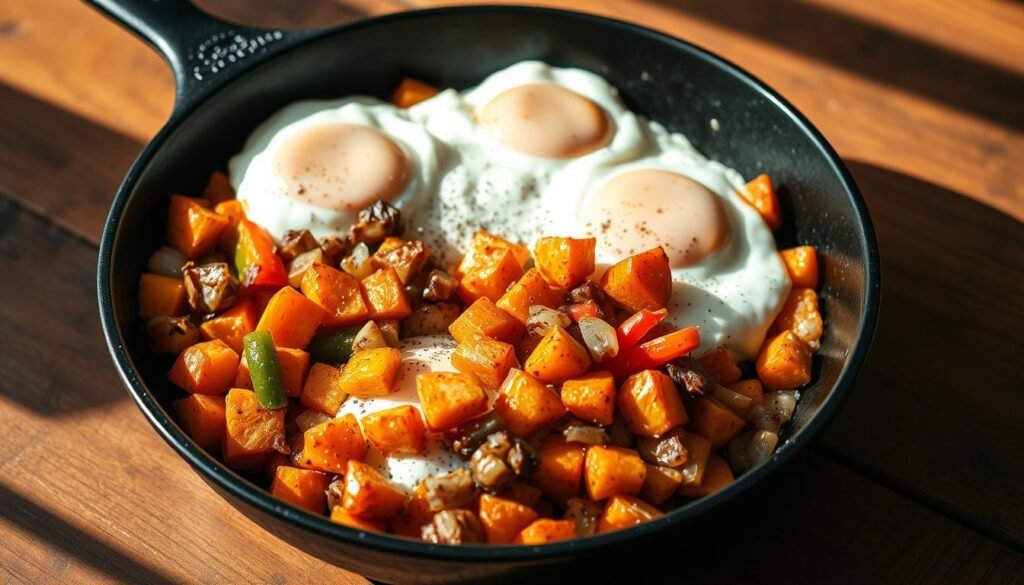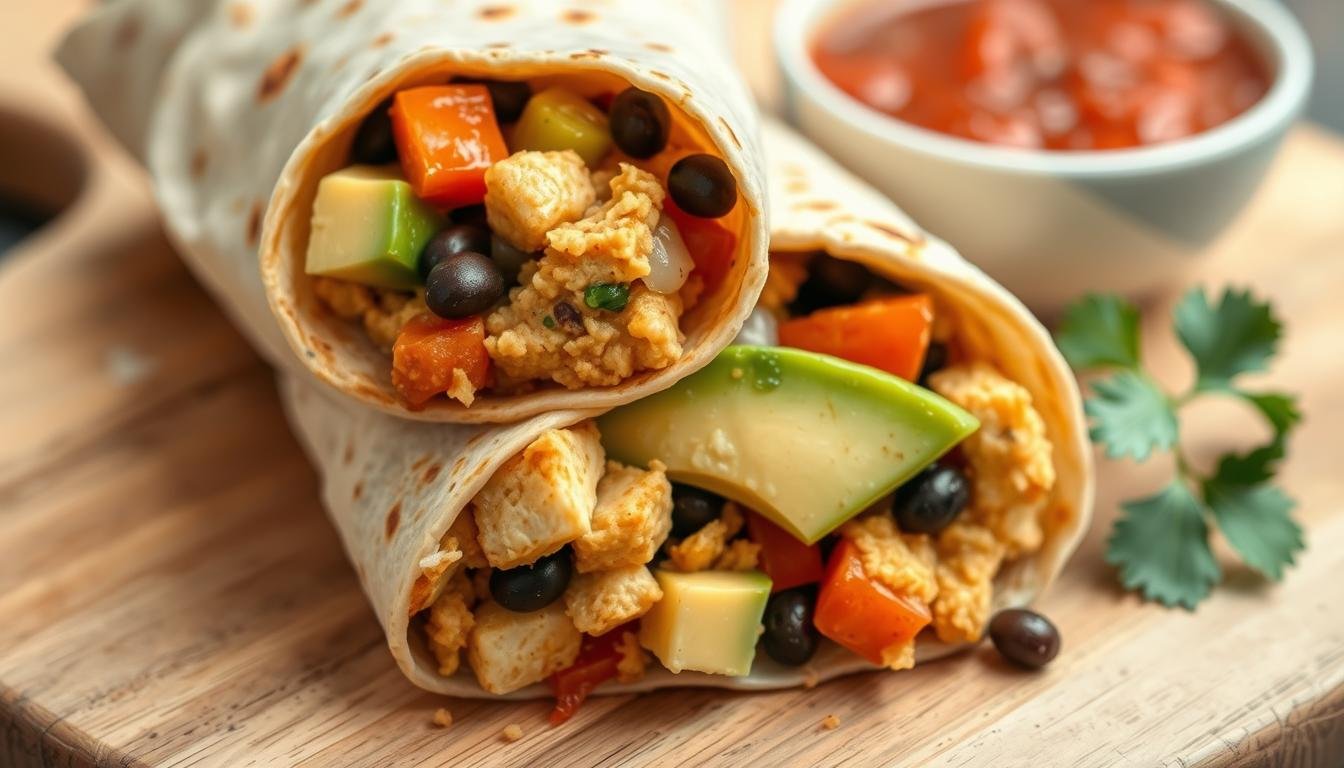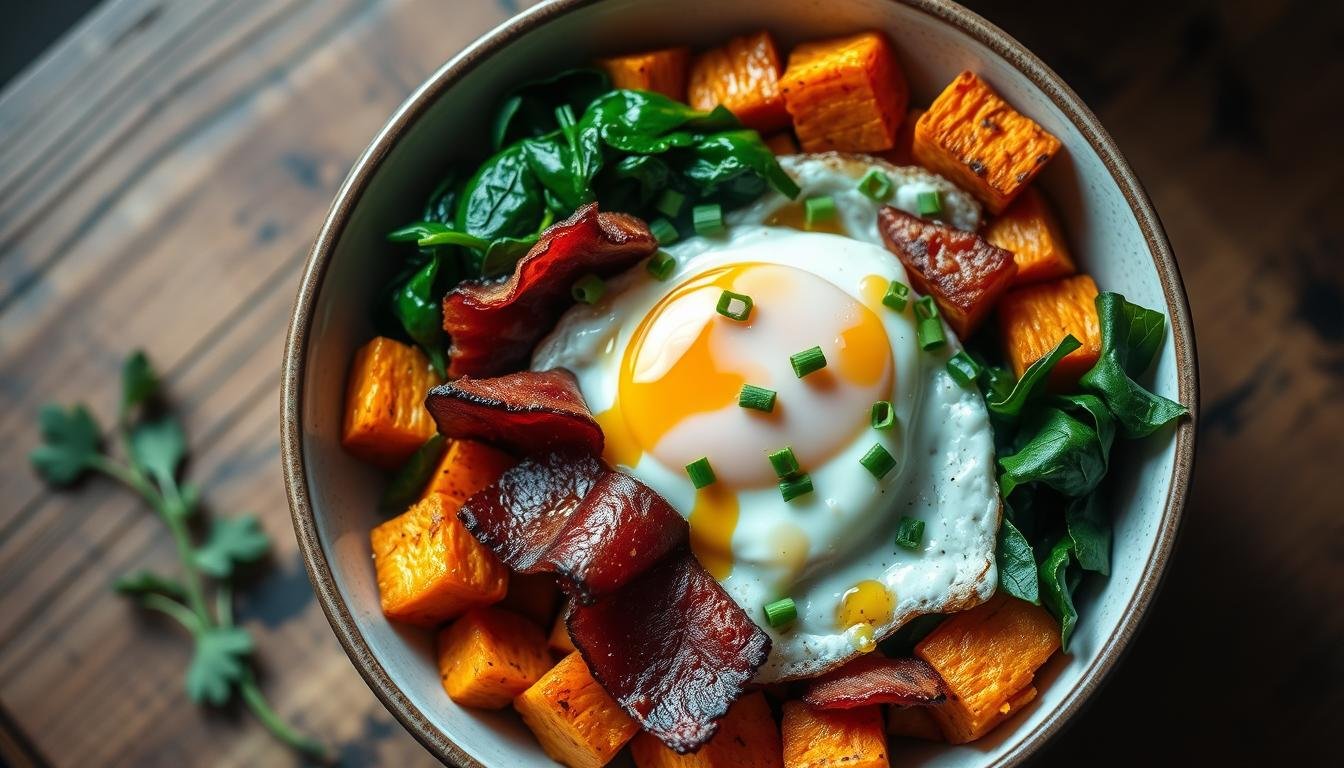I love a one-pan paleo breakfast that feels hearty but doesn’t weigh me down. This paleo breakfast skillet with sweet potatoes is perfect. It’s a simple, healthy breakfast that combines tender sweet potatoes, warm spices, and protein-rich eggs or your favorite paleo sausage or uncured bacon.
On busy mornings, I turn to the skillet or a sheet pan sweet potato hash to save time. Microwaving or pre-roasting the cubes cuts cooking in half. The result is a sweet potato breakfast skillet that’s quick, easy, and packed with protein and fiber.
I’ll show you a dependable, cast-iron method that yields about six servings. It’s flexible: make it dairy-free with coconut oil and full-fat coconut milk, turn it savory with bacon and onions, or sweet with apples and raisins. These paleo recipes are practical, Whole30-friendly options that make clean eating feel effortless.
Key Notes;
- One-pan paleo breakfast perfect for busy mornings.
- Sweet potatoes provide fiber and slow-release carbs for lasting energy.
- Versatile protein options: eggs, paleo sausage, or uncured bacon.
- Quick methods include microwave pre-cook or sheet pan hash for batch meals.
- Easy to make dairy-free and Whole30-compliant with coconut oil and milk.
Why I Love This Paleo Breakfast Skillet and Its Health Benefits
I make this skillet because it meets my morning needs. It’s quick, flavorful, and nutritious. It’s a standout among paleo breakfasts because it uses simple ingredients in one pan.
This approach makes cleanup easy. It supports a clean eating breakfast routine, whether it’s a busy weekday or a relaxed weekend.
Balanced macronutrients for all-morning energy
I aim for a plate that lasts until lunch. This skillet has quality fats, proteins, and carbs. It keeps my blood sugar steady and stops mid-morning cravings.
When I need more energy, I add extra eggs or cooked sausage. This makes it a high-protein paleo breakfast.
Sweet potatoes: fiber, vitamin A, and slow-release carbs
Sweet potatoes are the heart of this dish. They offer fiber, vitamin A, and slow-release carbs. This keeps my energy steady.
I choose organic sweet potatoes when I can. Roasting or sautéing them brings out flavor and keeps nutrients. They’re perfect for both savory and sweet skillet versions.
Protein sources and why eggs, sausage, and bacon work for paleo
Eggs are a key protein source. They’re versatile and high in protein. Pastured eggs add omega-3s when I can get them.
Uncured bacon and paleo sausage add flavor and fat. This helps absorb vitamins. I often use six eggs for sweeter, lower-carb versions.
Turkey bacon is a leaner option when I want less saturated fat.
Why this is a clean eating breakfast and Whole30-friendly option
This skillet follows clean eating principles. It uses whole foods and minimal processing. I choose ghee or coconut oil for Whole30-compliant fats and avoid added sugars.
Spinach or other greens add nutrients without extra effort. This recipe is flexible and reliable for paleo morning meals that fit an elimination plan.
Essential ingredients for a perfect skillet: paleo pantry checklist
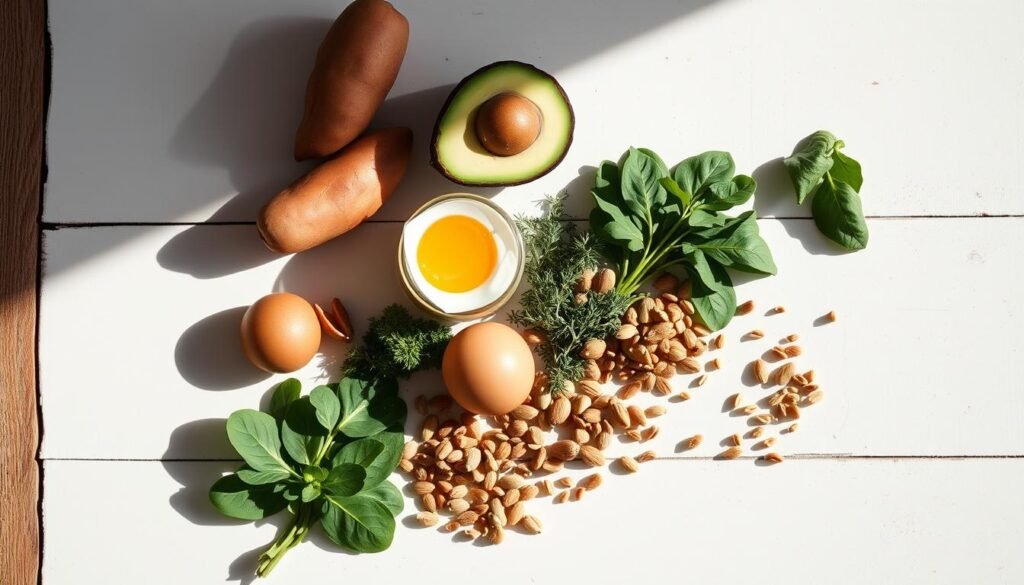
I keep a simple pantry for quick meals. It has shelf-stable fats, nuts, and dried fruits. This helps me make great paleo dishes fast.
I choose sweet potatoes by texture. Garnet ones are creamy. Beauregard and Japanese types are good for hashes.
I prefer proteins that are easy to use. I like eggs from local farms or free-range brands. Bacon and paleo sausage add flavor. Turkey bacon or lean sausage is good for lighter dishes.
Fats are important for cooking and taste. Ghee and coconut oil are great for high heat. Olive oil is better for gentle sautés.
Small add-ins make a big difference. Apples, raisins, and pecans add sweetness. Onions, green onions, and spinach add flavor.
For quick meals, I use baby sweet potatoes and microwave tricks. Freezing sausage and toasting pecans saves time. This makes easy paleo breakfasts a breeze.
My step-by-step method for the best paleo breakfast skillet with sweet potatoes
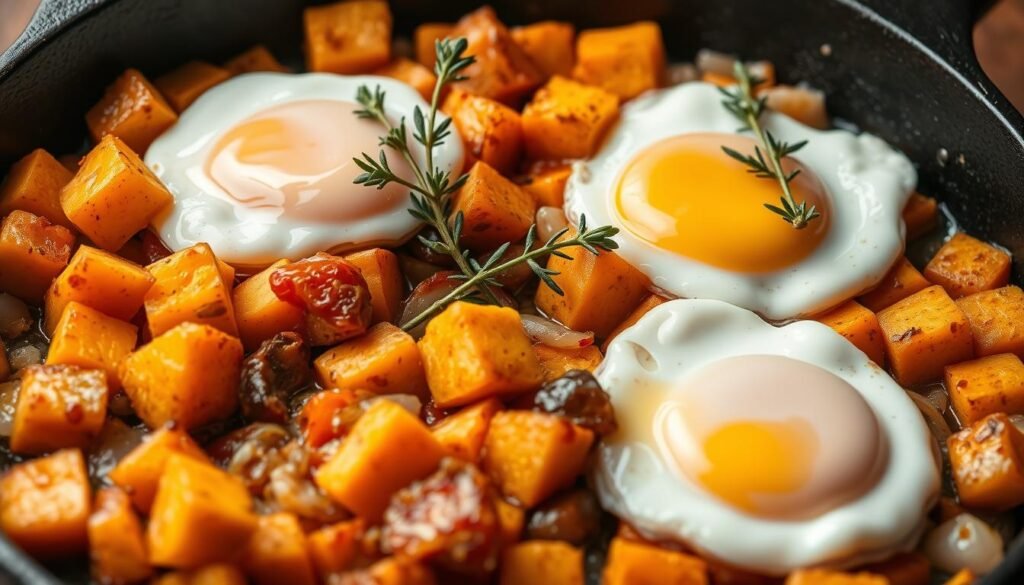
I make mornings easy with a simple one-pan paleo breakfast. First, prep by cutting sweet potatoes, onions, and measuring fats. Have eggs ready too. This prep makes mornings calm and quick.
I have three ways to make this breakfast. I bake in a cast-iron for a hands-off brunch. For quick crisp whites, I use stovetop and broil. And for a fast single-serve, I cook in a small skillet. Each method keeps the flavor the same but changes the texture.
Preparation
To speed up prep, I microwave sweet potatoes for 2–3 minutes. This softens them and cuts down sauté time. If I have more time, I roast them at 400ºF for 20–30 minutes or air fry for 10 minutes. Always salt the potatoes before cooking.
Cooking the base
I heat ghee or coconut oil in a cast-iron skillet over medium heat. Add diced sweet potatoes and cook 5–10 minutes until they start to soften and brown. Then, I add onions, apples, or bell pepper and sauté another 3–5 minutes. For a sweeter version, I stir in cinnamon and raisins and let them plump for 5–10 minutes, then fold in pecans and finish with a pinch of salt.
Adding proteins
If using cooked sausage or bacon, I add it to the sweet potato base toward the end of the sauté so fats meld and flavors deepen. For baked versions I remove the pan from heat, whisk eggs with room-temperature coconut milk, pour over the mixture, smooth the top, and sprinkle reserved pecans. For stovetop egg cooking I create wells in the potatoes, crack eggs into the hollows, and either cover the pan to steam the whites or transfer to the broiler.
Oven finish versus stovetop method
My baked technique begins with an oven preheated to 325ºF. After pouring the egg-coconut milk mix, I bake 20–35 minutes until a knife comes out clean, then cool ten minutes before slicing. For a faster finish I broil for 2–3 minutes to set egg tops and brown edges. For single-serve skillets I cover on low heat until the yolks reach desired doneness.
These steps keep the dish consistent whether I want a crowd-friendly breakfast skillet recipe or a quick easy paleo breakfast for one. Small adjustments in timing or fat choice let me pivot from a hearty sweet potato breakfast skillet to a lighter, vegetable-forward one-pan meal without extra cleanup.
Flavor variations and recipe ideas: sweet, savory, and high-protein options
I like to keep breakfast interesting by making small changes. These changes can change the taste and texture without extra work. Here are some ideas for sweet, savory, high-protein, and veggie-packed breakfasts that fit paleo diets.
Sweet version: mix grated apples, raisins, cinnamon, and coconut milk with eggs. Add toasted pecans on top for crunch. Use less raisins for less sugar. Serve with maple syrup or coconut yogurt. For fewer carbs, use more eggs.
Savory skillet: roast sweet potatoes in oil or ghee. Add chopped onion and bacon or turkey bacon. Make wells and top with broiled eggs. Add green onion before serving.
High-protein paleo breakfast: add more eggs and cooked sausage or bacon. Use meats like pastured sausage or turkey breast. This keeps you full longer and goes well with sweet potatoes.
Vegetable-forward option: add spinach, broccoli, bell peppers, and cherry tomatoes. Cook peppers and broccoli first. Wilt spinach before adding eggs. Top with avocado for healthy fats.
My favorite combos: apples, raisins, and pecans for sweetness; bacon, onion, and green onion for savory; extra eggs, sausage, and bacon for protein; and spinach, peppers, and tomatoes for veggies. These simple changes make one recipe into many delicious breakfasts all month.
| Variation | Key Ingredients | Best For |
|---|---|---|
| Sweet | Apples, raisins (reduced), cinnamon, toasted pecans, coconut milk | Those who want dessert-like mornings without processed sugar |
| Savory | Sweet potatoes, uncured bacon or turkey bacon, onion, green onion, olive oil | Fans of classic breakfast flavors and hearty, savory meals |
| High-Protein | 6+ eggs, sausage, extra bacon, roasted turkey breast | People aiming for a filling, low-carb start and sustained energy |
| Vegetable-Forward | Spinach, broccoli, bell peppers, cherry tomatoes, avocado | Anyone wanting extra greens and micronutrients in a paleo meal idea |
Easy paleo breakfast variations: skillet, sheet pan, and hash alternatives
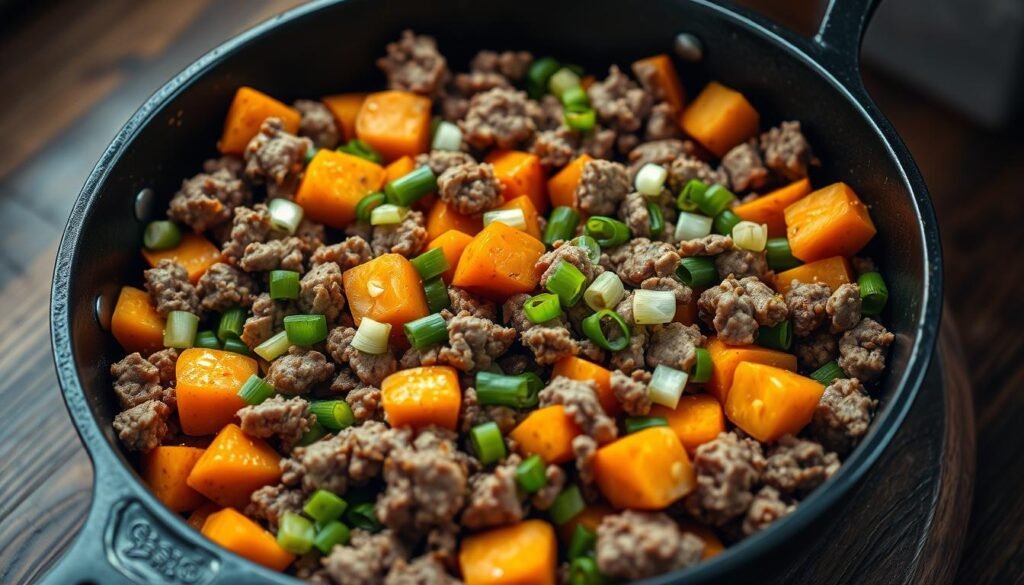
I like to change things up in the morning. A big skillet is great for groups, while a sheet pan is perfect for making food for the week. When I’m in a rush, a small cast-iron pan makes breakfast quick and easy.
For meal prep, I use a sheet pan. I toss sweet potatoes with olive oil and roast them at 400ºF for 20–30 minutes. Then, I add bacon and onion, make wells, and crack eggs into them. After broiling, the whites set, making a tasty breakfast hash.
For a dish that’s easy to take on the go, I make a sweet potato sausage hash. I cook sausage while the potatoes roast. Then, I mix the sausage with the potatoes, add parsley, and portion it out. This keeps breakfast fresh for four to five days.
My go-to for a quick breakfast is a 7-inch cast-iron skillet. I microwave sweet potatoes for two to three minutes. Then, I sauté them in ghee, add greens and sausage, and top with an egg. This makes a filling meal with little cleanup.
Some tips help keep things consistent. Microwaving sweet potatoes saves time. Air fryers make cubes crispy fast. Use ovenproof pans for broiling eggs without extra dishes. You can easily make more or less, depending on your needs.
Paleo meal prep and time-saving techniques for busy mornings
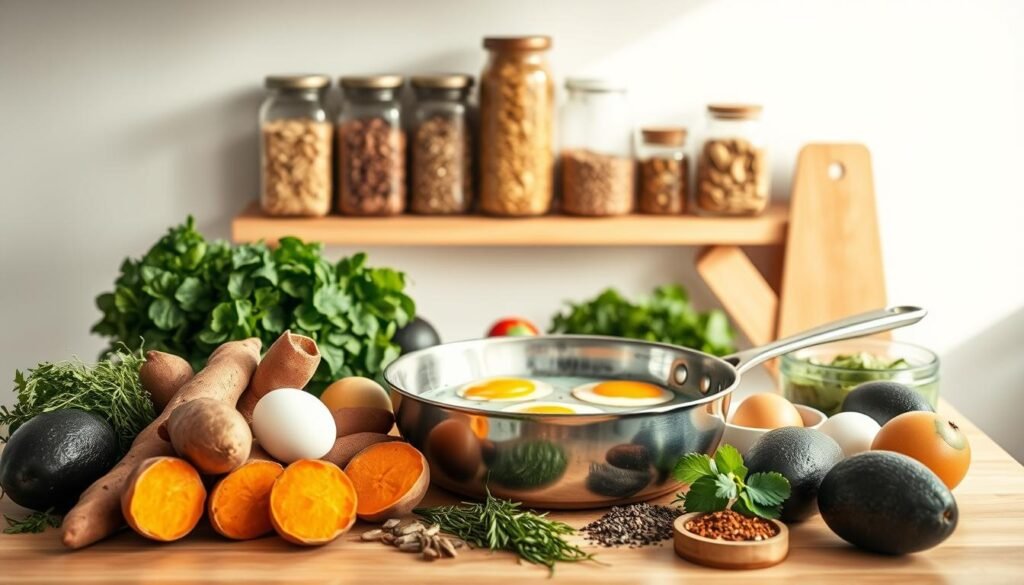
I keep mornings calm by prepping key parts of the skillet ahead. Little moves save time and keep flavor strong. Below I share practical paleo meal prep steps that make weekday breakfasts quick and reliable.
Make-ahead strategies: roasted sweet potatoes and storage
I roast extra sweet potatoes for 20–40 minutes depending on size, cool them, then store in airtight containers. Roasted cubes keep well in the fridge for 3–4 days. When I plan a sheet-pan batch I add onions and apples so I can mix and match paleo meal ideas all week.
Microwave pre-cook trick to halve stovetop time
I pierce whole sweet potatoes and microwave for 3–4 minutes or microwave cubed potatoes for 2–3 minutes. That partial cook cuts sauté time in half. For single servings I can keep skillet time under 10 minutes, which turns into a true time-saving paleo breakfast.
Batch-cooking proteins and freezing portions
I cook bacon, sausage, or turkey bacon in bulk, drain, and portion into freezer-safe containers. I label each pack with date and portion size. When I want an easy paleo breakfast I pull a portion, thaw briefly, and reheat with roasted sweet potatoes.
Reheating tips to preserve texture and flavor
I avoid the microwave for full reheats because it can make potatoes mushy. I reheat gently in a skillet over low heat with a splash of oil or water to restore moisture. For baked dishes I let the pan rest 10 minutes after heating so eggs set before slicing, which prevents a watery finish.
Below I keep a quick comparison to help choose the best make-ahead route for your week.
| Prep Method | Time to Prep | Storage | Best for |
|---|---|---|---|
| Roasted sweet potatoes | 20–40 minutes | Refrigerate 3–4 days | Sheet-pan breakfasts, quick skillet builds |
| Microwave partial cook | 3–4 minutes per potato | Use same day or refrigerate cubes | Single-serving time-saving paleo breakfast |
| Batch-cooked proteins | 20–30 minutes for a week | Refrigerate 4 days or freeze 3 months | Grab-and-go paleo meal ideas and easy paleo breakfast |
| Sheet-pan full assembly | 30–45 minutes | Refrigerate portions; reheat in oven | Family breakfasts and meal prep lunches |
Nutritional information and portion guidance for a healthy breakfast
I track the nutritional info for every skillet I make. This helps me balance flavor with nutrition. Sweet potatoes and eggs give steady carbs, quality protein, and fats that keep me full.
Typical macros: protein, fat, carbs from sweet potatoes and eggs
Sweet potatoes are full of complex carbs and fiber. Eggs offer protein and some fat. Adding coconut milk or nuts boosts fat and keeps me full longer.
Calories and nutrient highlights: vitamin A, fiber, omega-3 (if using pastured eggs)
A serving of two small sweet potatoes, three eggs, and olive oil has 200–350 kcal. Sweet potatoes give vitamin A and fiber. Pastured eggs add omega-3s and more nutrients than regular eggs.
How to adjust portion sizes for higher-protein paleo breakfast or lower-carb needs
For more protein, I add three or four eggs, or turkey sausage or bacon. This makes protein 20–30 g per meal.
To eat fewer carbs, I use one small sweet potato and add more veggies like spinach or bell pepper. For more satiety, I add full-fat coconut milk, avocado, or toasted pecans.
I suggest using a kitchen scale or app to track portions. Small changes can make a big difference. Measure when you first adjust a favorite recipe.
Common problems, troubleshooting, and pro tips for consistent results
I often make this sweet potato breakfast skillet. I’ve found quick fixes to save time and improve the texture. These tips will help you fix common issues and get great results on busy mornings.
To avoid sticky or burnt sweet potatoes, heat plenty of fat like ghee or coconut oil first. If the pan seems dry, add a bit of water while cooking to prevent burning. Using a cast-iron pan helps with even heat, and an ovenproof skillet is good for finishing in the oven without hot spots.
When cooking eggs, watch them closely to avoid dryness. Broil eggs for two to three minutes to set them. For baked eggs, let the pan rest for ten minutes after taking it out of the oven. This helps the eggs cook gently and keeps the dish clean and healthy.
To save time, microwave cubed sweet potatoes for two to three minutes. But be careful not to overdo it, as it can make them mushy. For whole potatoes, poke holes before microwaving or roasting to ensure even cooking and reduce baking time.
To add crunch, toast pecans near the end of baking or sprinkle them on and broil briefly. Add apples or raisins late to keep them from getting mushy. These tips make a simple dish special.
If you can’t have dairy, use coconut oil instead of ghee. For a pork-free option, try Applegate turkey bacon or paleo-friendly chicken sausage. If you want less sugar, skip the raisins and apples and add more nuts and eggs for a heartier dish.
When using coconut milk, whisk the coconut-water part first to avoid clumps. Add spinach and tender greens at the end to keep them fresh. For flavor, use everything bagel spice or a pinch of cayenne to add heat without non-paleo ingredients.
Conclusion
I really enjoy making the paleo breakfast skillet with sweet potatoes. It’s easy to make and can be sweet or savory. It’s packed with protein, fat, and fiber, making it a great healthy breakfast choice.
My favorite tips include microwaving sweet potatoes to save time. I also use ghee or coconut oil for a Whole30-friendly option. Letting the skillet rest helps the eggs set perfectly.
Try different versions of the recipe and use high-quality ingredients. Pastured eggs and good fats are key. Use these tips to make mornings easier and more enjoyable.

